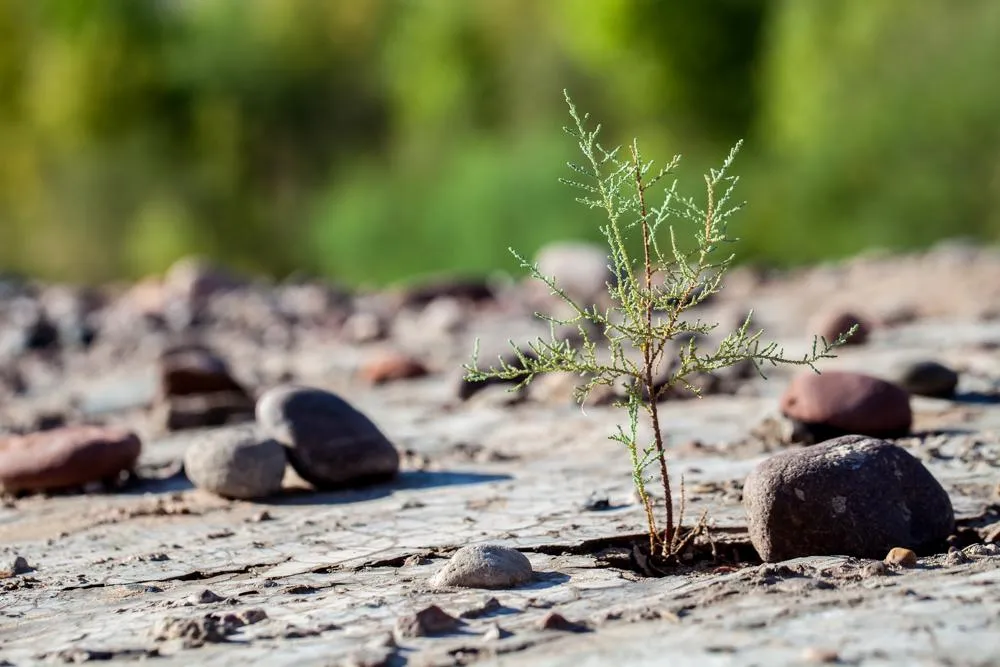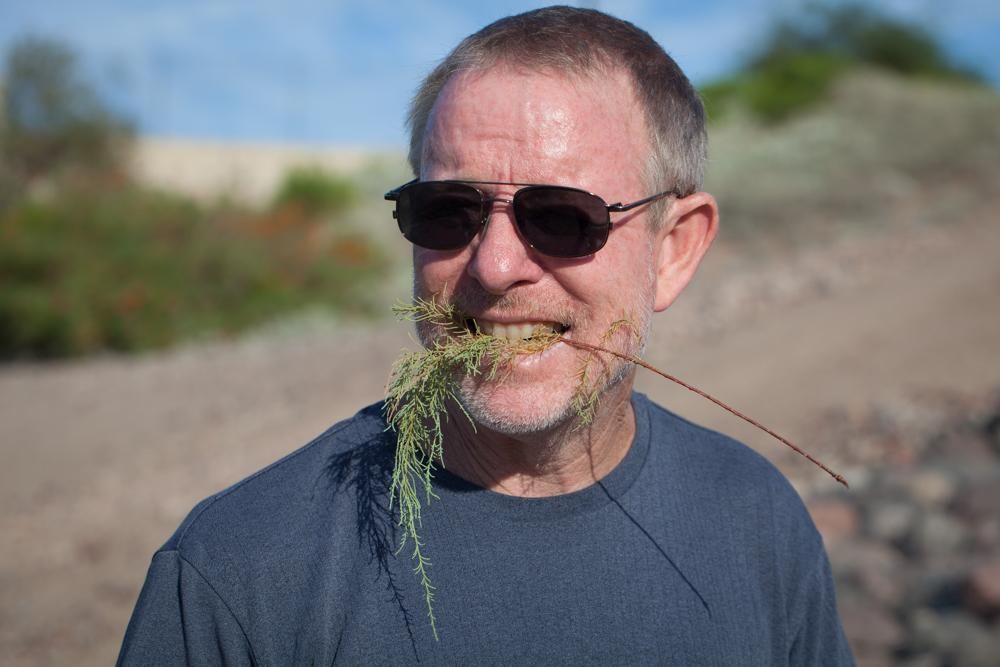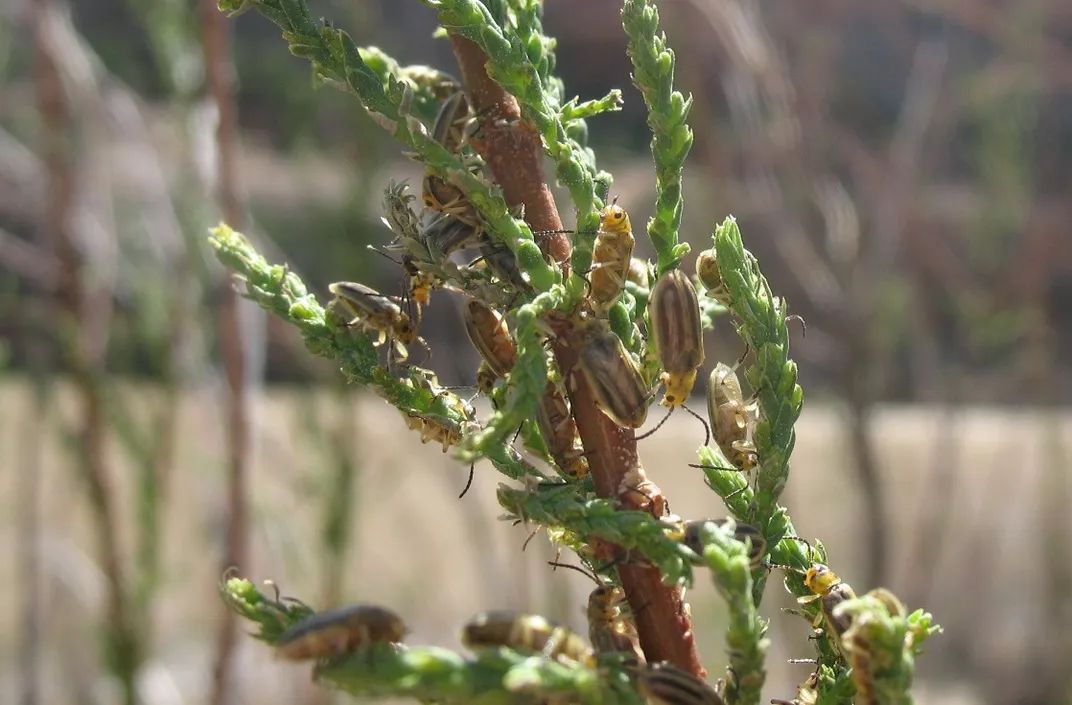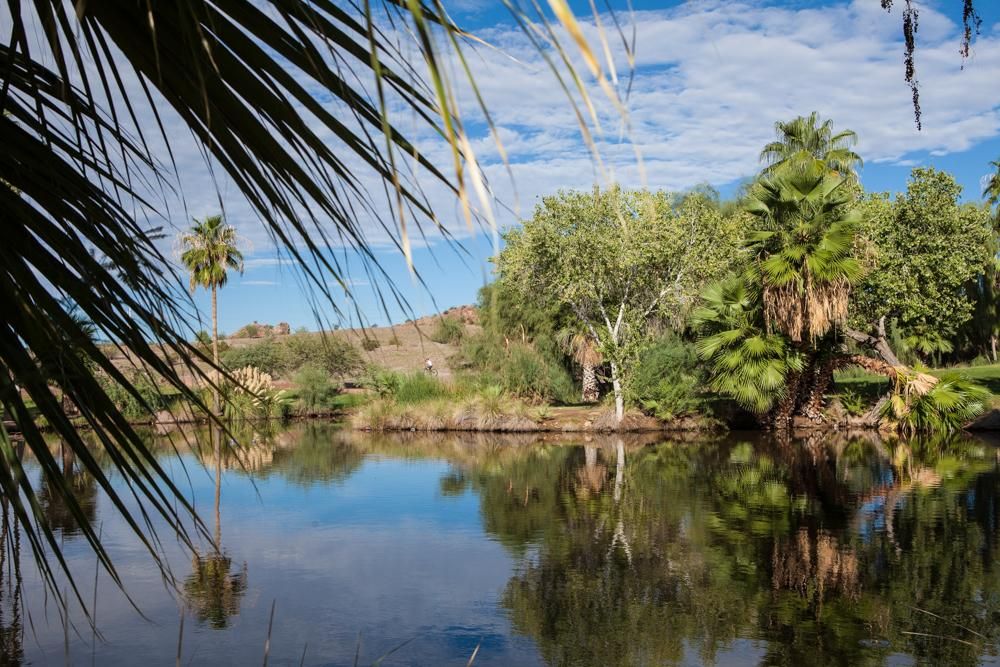How We Created a Monster In the American Southwest
The salt cedar is often seen as an un-killable invader. But are humans the real reason this unwanted plant is thriving?
/https://tf-cmsv2-smithsonianmag-media.s3.amazonaws.com/filer/45/fd/45fd811a-54fe-4cba-9571-55a4fb597d8a/2015_09_arbas_salt_cedar_az-29.jpg)
Around 6:30 on a weekday morning, planes departing Phoenix International Airport scream over the Salt River every few minutes.
The constant roaring over this riparian area is only one example of how the riverbed ecosystem is changing. Two hundred years ago, the Salt River would have been regularly scouring the banks to wash away salty soil, while cottonwoods, willows, mesquite and native grasses would have been flourishing.
Now it is rarely a free-flowing river throughout its system; dams and drought have dried it up. Part of the riverbed has been bulldozed to channel floodwater and control mosquitoes, and tire tracks are visible in the sand. There is just one cottonwood, and some Australian willow acacia, buffelgrass and mesquite are still visible. There’s also fan palm growing along with non-native salt cedar.
To some environmental groups, the salt cedar, a wispy bush with feathery pink flowers that attract bees, dragonflies and hummingbirds, is the scariest sight on the river.
This morning Matthew Chew, an Arizona State University biology professor, walks over the Priest Road bridge along the Rio Salado Habitat Restoration Area between Tempe and Phoenix. He must speak loudly to be heard above the planes, however it’s easy for him to shout about a subject he calls the “monstering” of the salt cedar.
The plant, also called tamarisk, began to take root in the United States in the 1800s, with federal government approval to bring in the bush, originally from Europe, to help control erosion. As the plant established itself along stream banks, attitudes began to change. The tamarisk is now listed as an invasive plant by the U.S. Department of Agriculture.
A Nature Conservancy website says salt cedar “sucks large amounts of water from the ground, transforming valuable desert streams and ponds into salty dry basins,” and it calls salt cedar one of “the worst weeds.” Farmers and ranchers also dislike the tamarisk, saying it's an extraordinary water user and takes up space where grasses might grow to feed cattle. “The biggest issue is water consumption,” says Julie Murphree, the Arizona Farm Bureau’s communications director.
Federal and state agencies have spent millions of dollars of taxpayer money on removing the tamarisk, and nonprofit groups such as the Tamarisk Coalition have spent countless hours attempting to subdue it. You can’t burn it—it grows back. You can’t pull it out without effort, and herbicides don’t necessarily work. It’s not surprising that many in the Southwest see the tamarisk as a monster.
However, the story may be more complicated.

People around the world are changing the environment with unprecedented speed and unknown consequences. In Arizona, many of those changes are due to dams.
Roosevelt Dam, built in the early 1900s about 90 miles east of what is now downtown Phoenix, tamed the Salt River and made downstream agriculture possible. But it also dried up the river in Phoenix. It, along with other dams built in the West since then, may be responsible for the salt cedar's spread.
“The Reclamation era of dams has pulled the rug out from under native vegetation,” Chew says. The salt cedar, meanwhile, has a unique ability to shut down and wait out dry spells.
Chew feels the backlash against the plant has replaced proper science, which is no longer being used to back up the contention of undue water use and crowding out of other plants and trees.
As he makes a wreath out of a tamarisk branch, he decries the “tammy whackers.” “We have created an environment for the tamarisk,” he says.
Now, Chew and other scientists are looking at how tamarisk has become part of the riparian mix. Where tamarisk is replacing willows and cottonwood, the plants provide essential habitat for the endangered Southwestern Willow flycatcher and other animals. In addition, removal of the tamarisk is costly and doesn’t take into consideration the complicated puzzle of how dams affect native trees.
“Cottonwoods and willows have adapted to produce their seeds during spring floods, but tamarisk evolved to produce seeds year round,” Chew says. With floods now held back by dams, the seasonal water no longer arrives so that the native seeds can grow in wet soil.
Edward Glenn, a University of Arizona professor emeritus, has been studying the tamarisk for 20 years.
“When I first starting working on riparian plants, I accepted that salt cedar used more water than native plants and outcompeted them in other ways,” says Glenn. But he began to think differently after running some experiments.
Salt cedar, Glenn says, can tolerate saltier soil than native plants and pull water from deeper underground, but otherwise doesn’t compete with them. "As our rivers have been dammed and otherwise altered, the soils in the riverbanks have become much saltier and the water table is further down, hence salt cedar has spread. Simply removing salt cedar won't solve those problems,” he says.
The tamarisk is a common but not a dominant plant, Glenn says. Furthermore, his research shows that it is not as heavy a water user as people say.
“I’ve gone to workshops with the volunteers and discussed the volume of water use. We just disagree with them, that it’s a harmful plant that needs to be removed, but there’s room for discussion,” he says. “The real invasive species are the dams diverting water for agriculture and saline water being put back in the rivers.”
Juliet Stromberg, a plant ecologist and Arizona State University professor, is studying the tamarisk as well as the larger issue of how to define a native plant. She believes that if normal stream flows were occurring as Phoenix saw in the 1970s and 1980s, native species would be seen more readily along with the tamarisk.
If cottonwoods have moisture at the right time, they will grow alongside tamarisks, even outcompeting them, she says.

Besides, efforts to remove the tamarisk can be more destructive than leaving it alone, Glenn says. First of all, killing it is just plain difficult. Glenn has seen Bureau of Land Management employees putting tires around the roots of a salt cedar and attempting to burn it out, but the plant soon grows back. Herbicide on the roots doesn’t work well either.
In the 1990s, the USDA released a “bio beetle” in an attempt to eradicate the plant. The beetle devours tamarisk—but just as the endangered flycatcher is ready to nest and lay eggs.
Although the insect is now banned because of its harm to the flycatcher's habitat, it has spread throughout the Southwestern United States and still is seen by some as an effective method of eradicating the tamarisk.
Even U.S. Sen. John McCain, R-Ariz., likes the beetles. He is working with the Arizona Farm Bureau to support use of the bio beetle to remove the bush’s leaves. Although the insect has been banned, McCain has sent a letter to the Interior and Agriculture secretaries asking them to reconsider, since the drought in the American West is creating an environment more hospitable to the salt cedar. McCain says the beetles are one of the more successful and cost-effective methods of removing the non-native trees.
Further complicating the issue, after tamarisk was removed from the Virgin River in Utah, a 2005 flood showed what happens when the plant is no longer there to control erosion. “A whole bunch of sediment moved downstream,” Glenn says. That loss of soil makes the stream banks less hospitable for all plants. Glenn says “science is not on the side” of removing all tamarisk, which would leave barren riverbanks.

Environmental groups are not yet convinced. The Tamarisk Coalition, created in 1999 to control tamarisk, still removes the plant over hundreds acres of land in the Southwest yearly (though the nonprofit now focuses on stream health overall and not simply invasives eradication).
Mark Larson, a Scottsdale resident and president of the Maricopa Audubon Society, feels the tamarisk is crowding out Fremont cottonwoods and Goodding’s willows, the traditional native species, as well as robbing the trees of water.
“Most of the environmental science I know and have run across in a 35-year career is nothing other than the consequence of introducing an invasive species from Africa that doesn’t belong here and never should have been introduced,” he says.
The Maricopa County chapter of the Audubon Society isn’t removing tamarisk due to the lack of volunteers, but members are avid letter writers and began concerning themselves with the issue 20 years ago, he adds. Larson believes the tamarisk should stay where the flycatcher is found, but nowhere else.
Although the Grand Canyon Chapter of the Sierra Club isn’t currently working on tamarisk, the group is sensitive to the complications of the issue.
“We have removed some in the Rio Salado, some on the Verde and quite a lot on the Agua Fria” rivers, says Sandy Bahr, chapter director. “We would like to see native endemic vegetation restored, especially cottonwoods and willows, but understand that we have to have more natural flow regimes to support those trees.
“We don’t want barren rivers and streams, but ideally we want to work to have native vegetation. That being said, we know that the Southwestern Willow flycatcher uses tamarisk and the flycatchers are endangered, so removal must consider the impact to these and other species, especially where there is no alternative,” Bahr said in an email.

Any decisions about how to treat the plant are, ultimately, context-dependent. Leaving tamarisk alone or pulling it out depends on whether area managers want wild vegetation or a river that can be used for fishing and other recreation, Chew says, in which case the salt cedar would need to be managed like any other large plant.
Chew has even had to engage in a little management of his own. He had to remove a tamarisk plant when he found it growing in the middle of a raised bed in his backyard vegetable garden near South Mountain in Phoenix. “I just ‘gardened’ it out,” he quips. It hasn't returned—yet.